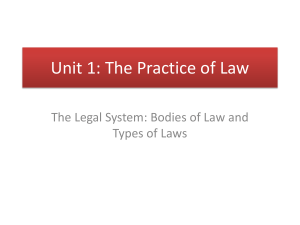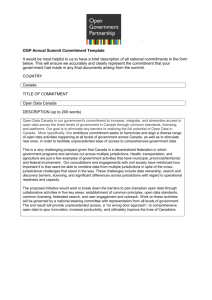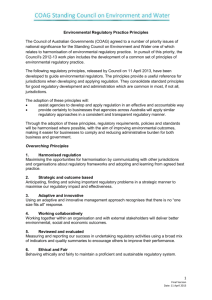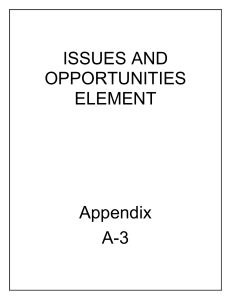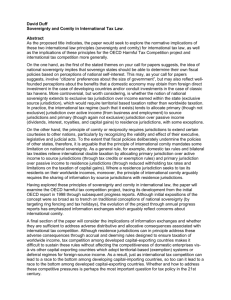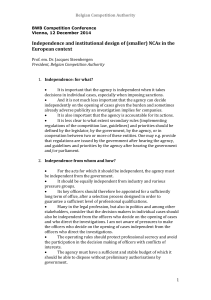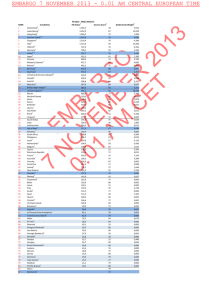THE ECONOMIC DEVELOPMENT FUND
advertisement
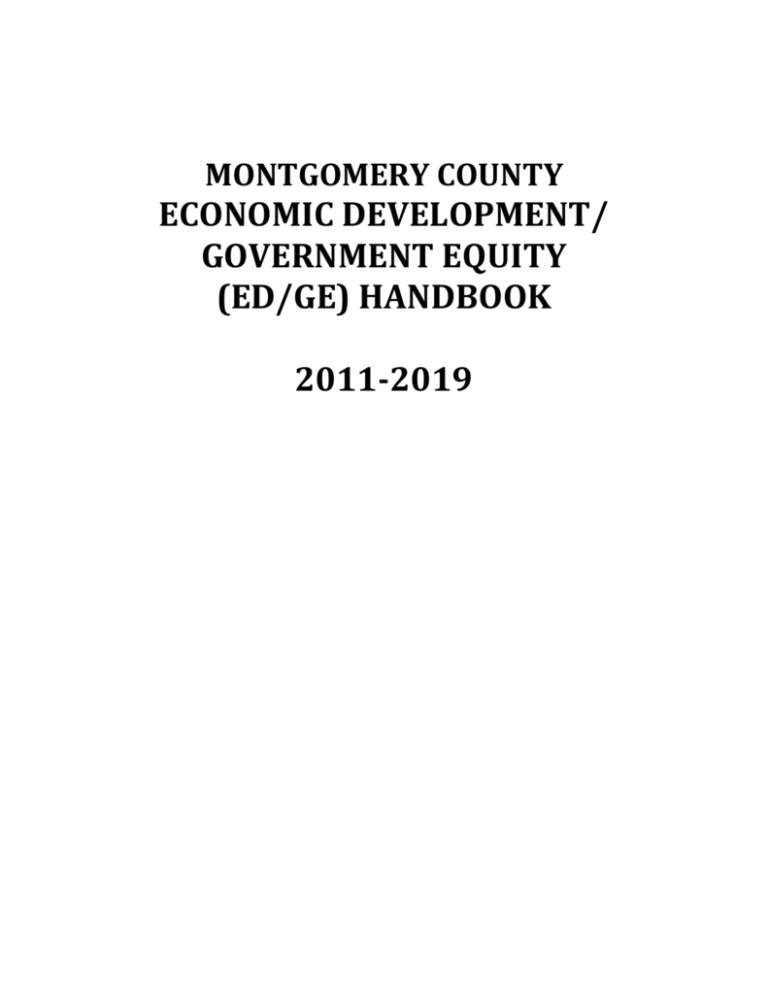
MONTGOMERY COUNTY ECONOMIC DEVELOPMENT/ GOVERNMENT EQUITY (ED/GE) HANDBOOK 2011-2019 TABLE OF CONTENTS The ED/GE Program 2 The Economic Development Fund 3 The Government Equity Fund 4 Settle-Up Provision 5 Funding Cycles 6 Funding Process 6 Award of Grant 6 Implementation and Completion Requirements 7 ED/GE Advisory Committee 7 Administration of the Program 7 Contact Information 7 Appendix 1 THE ED/GE PROGRAM The ED/GE Program, which began in 1992 and has recently been renewed for another nine years (2011-2019), was created to spur economic growth, as well as create regional cooperation between its jurisdictions. This is accomplished with two separate, but interrelated, funds – the Economic Development Fund (ED Fund), which enables participating jurisdictions to apply for grants each year (amount available to be determined by the Board of County Commissioners each year) and the Government Equity Fund (GE Fund), which provides each participating jurisdiction with the opportunity to profit from economic growth in the County, regardless of where the growth occurs. THE ECONOMIC DEVELOPMENT FUND (the “ED” of ED/GE) The overall purpose of the Economic Development Fund is to assist townships, villages and cities in promoting economic health and in taking advantage of economic opportunities for their citizens. Specifically, the Economic Development Fund will use its resources to establish or expand commercial, industrial and research facilities and create and preserve job and employment opportunities. The Economic Development Fund enables communities to fill funding gaps and take advantage of strategic economic opportunities. In fact, 5% of the Economic Development Fund resources is specifically reserved for responding to unexpected economic opportunities or threats that occur between funding cycles of the program (Opportunity Reserve Fund). Two million dollars ($2,000,000) will be made available for the Economic Development Fund from sales tax revenues for the year 2011. In the remaining eight years of funding (2012-2019), the allocation will be determined annually by the Board of County Commissioners. These resources can be used to support a broad range of economic activities. The Fund will primarily support public infrastructure improvements critical to particular economic development projects. However, the Fund will also support other legally-allowable activities that foster economic development. Policy criteria and guidelines focus priority on projects that: • • • • • • • • • Create new jobs in existing local companies or retains existing local jobs Meet or support Strategic Economic Development Investment goals Encourage infill growth in areas already served by basic public infrastructure Invest in “high growth” industries and markets Are a joint effort between two participating jurisdictions Limit speculative development Discourage interjurisdictional relocation Leverage private, non-profit and/or other government monies Are ready to be implemented. 2 Eligibility to participate in the Economic Development Fund is limited to political subdivisions that choose to be partners and are a party to the nine-year ED/GE Agreement. In conclusion, the Economic Development Fund will: • • • • • Provide resources to local governments to respond to changing economic opportunities and conditions Nurture intergovernmental cooperation Allow for systematic development of communities Leverage other resources to create and retain employment Further enhance the local area’s ability to compete successfully in a global economic marketplace. It will primarily assist innovative, entrepreneurial economic development projects that are ready to be implemented, but will also address unexpected – the 5% -- economic development opportunities (Opportunity Reserve Fund). THE GOVERNMENT EQUITY FUND (the “GE” of ED/GE) The overall purpose of the Government Equity Fund is to share some of the economic benefits (i.e., increased revenue) resulting from new economic development among the jurisdictions of Montgomery County. Specifically, the goal of the Government Equity Fund is to: • • • • Foster productive interlocal competition in pursuing economic development opportunities Strengthen the fiscal capacity of local governments to promote regional economic growth Share the costs and benefits of economic growth to promote economic health in all communities Promote reasonable and environmentally sound development practices. Participating townships, villages and cities in Montgomery County will make annual contributions into the Government Equity Fund based on a single countywide growth contribution formula and receive annual distributions resulting from a distribution formula which is based on population. In general, the difference between the contribution and distribution formulas will result in net distributions for declining, stable or slow growth jurisdictions and net contributions for fast growth jurisdictions. The growth contribution formula for calculating the annual contributions to the Government Equity Fund for individual participating jurisdictions is calculated in two steps: First, a single countywide growth contribution rate is calculated: Growth Contribution Rate 1/3 of Growth in Property & Income Taxes for Participating Jurisdictions Over Base Year Increase in Assessed Valuation for Participating Jurisdictions Over Base Year = 3 The single countywide growth contribution rate includes the growth in property and income tax revenues as both are affected by development in individual jurisdictions. Because each jurisdiction’s access to and use of property and income taxes varies, neither tax source can be used alone in the growth contribution rate. The growth contribution rate calculation only includes the growth in revenues for participating jurisdictions; it does not include the growth in revenues for school districts or the county government’s share of property taxes. Only one-third (1/3) of the growth in property and income taxes over the base year will be included in the growth contribution rate; none of the development prior to the base year is included in the growth contribution formula. One-third (1/3) was selected as a level that is low enough to permit the delivery of key jurisdiction services, but high enough to distribute the benefits of development. For the contribution and distribution formulas, the base year is 2007. After the third year, the base year will advance one year annually. An individual jurisdictions’ contribution will, therefore, be based on its growth experience over the prior three years. Both the growth contribution and distribution formulas will use independent, verifiable and annually updated data. Second, the contribution for each jurisdiction is calculated: Individual Jurisdiction Contribution = Growth Rate Contribution Rate x the Sum of: 100% of Increase in Commercial & Industrial Property Assessed Valuation Over the Base Year + 25% of the Increase in Residential Property Assessed Valuation Over the Base Year + 50% of the Increase in Property Tax Revenues Over the Base Year + 50% of the Increase in Income Tax Revenues Over the Base Year Growth in residential assessed valuation is adjusted to 25% since although residential property represents a development investment in a community, it is not as directly tied to economic growth as is commercial and industrial development. Increases in property and income tax revenues are included in the Growth Contribution formula since they also reflect the impact of economic development, along with the increases in assessed valuation. The distribution formula for calculating the annual distribution from the Government Equity Fund for individual participating jurisdictions is: Individual Jurisdiction Distribution = Government Equity Fund x 4 Jurisdiction Population Total Population of Participating Jurisdictions In essence, the distribution formula also establishes a uniform rate for calculating distributions based on dividing the total of individual jurisdiction contributions over the base year by the overall population of the jurisdictions. The distribution to individual jurisdictions is calculated by multiplying the uniform rate by the population of each jurisdiction. Population is a distribution method already used in a number of distribution formulas familiar to Ohio local governments (i.e., Local Government Revenue Assistance Fund). A number of protections and safeguards are built into the process and the formulas to preclude contributions that are unduly burdensome and to provide jurisdictions with information critical to their internal planning processes. They include: • • • • • Contribution and distribution calculations for individual jurisdictions will be calculated before the fiscal year begins so that jurisdictions will have this information in advance of preparing annual budgets. Jurisdictions will be notified of net contributions due or net distributions expected in mid-September. Contributions and distributions will be made in April to allow time for initial collection of property and income taxes for the fiscal year (other legally allowable revenue sources may be used to meet the contribution obligation). Payment of sum obligation is due and payable by April 15 of each year. Net distributions will be distributed by the County on or before April 30 of each year. The contribution (prior to the distribution) for individual jurisdictions will not be greater than 13% of their growth in property and income tax revenues from the base year to the comparison year. Net contributions will be less than 13% of the growth in property and income tax revenues since every jurisdiction will receive a distribution based on their population. If there has been a decline in both property and income tax revenues from the base year to the comparison year, the jurisdiction contributes nothing. All contributions will be distributed in the same year as they are collected and can be used by jurisdictions for any purposes. Growth in revenues (property and income tax) due to millage and rate increases between the base year to the comparison year will be factored out. Individual jurisdictions that experience fiscal problems beyond their control will be considered for late contribution payments to the Government Equity Fund. SETTLE-UP PROVISION The ED/GE Program provides for a settle-up provision every three years, by which the Government Equity (GE) Fund contribution amounts of each member jurisdiction are compared to the dollar amounts each received through the Economic Development (ED) Fund. If the member jurisdictions’ contributions to the GE Fund exceeded the amounts it received from the ED Fund, the jurisdiction is entitled to an allocation in the amount of such excess from the ED Fund balance. This allocation may be used by the jurisdiction at its discretion. The jurisdiction may also opt to apply the excess amount to an economic development project from the next distribution of the ED Fund, so long as the project qualifies for funding under the guidelines and criteria established by the ED/GE Advisory Committee. 5 FUNDING CYCLES There are two funding cycles per year. Application packets are mailed to participating jurisdictions on January 31 (or the last working day of January) for the Spring cycle and August 31 (or the last working day of August) for the Fall cycle Applications are due in the Community and Economic Development Office by 5:00 p.m. on April 1 (or the first working day of April) for the Spring cycle and November 1 (or the first working day of November) for the Fall cycle. Funding notification is usually accomplished within six weeks of the deadline. The balance of funds remaining from the Spring cycle will be available for the Fall cycle. FUNDING PROCESS Summaries and a staff evaluation are completed on each project application and distributed to the ED/GE Advisory Committee for review. The ED/GE Advisory Committee tours each of the project sites by bus and applying jurisdictions are given the opportunity to make a short presentation on the bus. ED/GE Advisory Committee members rank the projects and meet to discuss and make funding recommendations to the County Commissioners Jurisdictions are notified by letter of the Advisory Committee’s recommendations and advised when the County Commissioners will be taking action on the recommendations. The County Commissioners act on the Advisory Committee’s recommendations by resolution. Jurisdictions are sent a copy of the certified resolution approving the recommendations (the date of this resolution is the “award date”). Once notified of approval, the jurisdiction must provide a current work program and budget for the project to County Economic Development staff. A resolution and contract will be prepared for approval by the County Prosecutor. Once approved, it will be submitted to the jurisdiction for signature and then to the County Commissioners for passage. A certified copy of the resolution and contract will be sent to the jurisdiction upon passage (the date of this resolution is “the contract date”). AWARD OF GRANT Any ED/GE grant given to a member jurisdiction will be awarded as follows: (1) Seventyfive percent (75%) of the grant amount will be reimbursed to the jurisdiction on an invoice basis; (2) Twenty-five percent (25%) of the grant amount will be reimbursed to the jurisdiction at anytime during a three (3) year period commencing with the full execution of the agreement (the contract date) that the recipient/business of the grant funds attains thirty-three percent (33%) of the total pledged jobs. 6 IMPLEMENTATION AND COMPLETION REQUIREMENTS Projects must be under contract and under construction within six months (three months for Opportunity Reserve projects) of the award date or the applicant must apply to the Advisory Committee for re-authorization of funding. Projects must be completed within 24 months of the date of the award date. ED/GE ADVISORY COMMITTEE The ED/GE Advisory Committee consists of 15 members: 2 County Commissioners, 1 representative each from the Cities of Kettering and Dayton, 3 private sector representatives and the remainder from the participating jurisdictions on a rotating basis of two or three-year terms. The Committee is responsible for reviewing all individual project applications and measuring those requests against established ED/GE criteria and guidelines. From year to year, the Committee may also recommend additions and/or deletions to the criteria and guidelines (Appendix A). ADMINISTRATION OF THE PROGRAM Members of the Montgomery County Department of Community and Economic Development staff will administer the ED/GE Program. The Department has been designated as the County Office of Economic Development under Ohio Legislature legislation (HB 173, effective October 30, 1989). In addition, the Montgomery County Office of Management and Budget will be responsible for the implementation of the Government Equity Fund formulas. CONTACT INFORMATION Linda Gum, ED/GE Coordinator Montgomery County Department of Community & Economic Development 451 W. Third St., 10th Floor Dayton, OH 45422 guml@mcohio.org 937.225.5711 (office) 937.225.6036 (fax) 7
